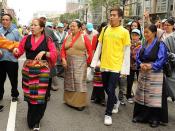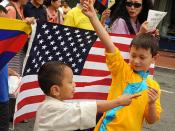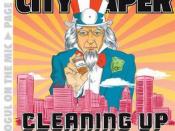Immigrants have been coming over to America for more than a century. Many minority groups are right here in Baltimore. In this paper I will compare two of the minority groups found in Baltimore and the troubles they have faced trying to make a new life in this country. Hispanics and Tibetans have both come to America in hopes of new opportunities.
An article that appeared in the Baltimore City Paper, titled "East Meets the East side," was about an elderly, Jewish woman named Barbara Apolonio, who helped exiled Tibetans set up lives in Baltimore. She plays a significant role in the community of Baltimore City, and has played an immense part in bringing the little Tibetan community together. She helps out with the Ja Ling Tibetan Buddhist Cultural Center and has six Tibetans living in the house next door. In 1949, when China took over Tibet and they were no longer allowed to practice Buddhism, many Tibetans fled the country.
Buddhism is a major aspect of the Tibetan culture. The six Tibetans now living together, had come together much like the way Nancy Abelmann encountered the women in her book. Geshe-La, who was the first of the six to come to Baltimore, came to teach at the Ja Ling Cultural Center. Then he invited his friend Tsering Dorje, who was in a Chinese prison for almost a year. Following, was a woman, Tenzin Paldon, who serves as the house translator. Her husband Kalsang Topgyal, who also lives in the home, is a law student. Twenty-three year old Sonam Donup grew up in India and moved to the United States in 2001. Lham Norkey heard about Ja Ling through a friend and decided to come to Baltimore. They have all gotten jobs, and some even have received permanent...


